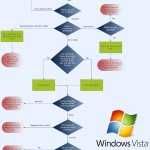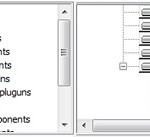Beginning from Windows Vista, each editions of Windows operating system is available in both 32-bit and 64-bit versions (x86 and x64 are terms used by Microsoft), making the 64-bit OS option a widely available choice going forward. And with almost all CPU processor and motherboard nowadays is x64 based which capable of running 64-bit OS, it presents hard decision to consumers to decide and pick whether 32-bit or 64-bit versions of Windows Vista is suitable choice.
Microsoft publishes KB946765 which details the main differences between 32-bit and 64-bit Windows Vista, which mainly relate to memory accessibility, memory management, and enhanced security features, as listed in table below.
| Architecture | Windows Vista, 32-bit versions | Windows Vista, 64-bit versions |
|---|---|---|
| System requirements | 1-gigahertz (GHz) 32-bit (x86) processor or 64-bit (x64) processor, 512 MB of RAM |
1-GHz 64-bit (x64) processor, 1 GB of RAM (4 GB recommended) |
| Memory access | A 32-bit version of Windows Vista can access up to 4 GB of RAM. | A 64-bit version of Windows Vista can access from 1 GB of RAM to more than 128 GB of RAM. |
| Memory access per edition | All 32-bit versions of Windows Vista can access up to 4 GB of RAM. | Windows Vista Home Basic – 8 GB of RAM Windows Vista Home Premium – 16 GB of RAM Windows Vista Business – 128 GB of RAM or more Windows Vista Enterprise – 128 GB of RAM or more Windows Vista Ultimate – 128 GB of RAM or more |
| DEP | 32-bit versions of Windows Vista use a software-based version of DEP. | 64-bit versions of Windows Vista support hardware-backed DEP. |
| Kernel Patch Protection (PatchGuard) | This feature is not available in 32-bit versions of Windows Vista. | This feature is available in 64-bit versions of Windows Vista. Kernel Patch Protection helps prevent a malicious program from updating the Windows Vista kernel. This feature works by helping to prevent a kernel-mode driver from extending or replacing other kernel services. Also, this feature helps prevent third-party programs from updating (patching) any part of the kernel. |
| Driver signing | Unsigned drivers may be used with 32-bit versions of Windows Vista. | 64-bit versions of Windows Vista require that all device drivers be digitally signed by the developer. |
| 32-bit driver support | 32-bit versions of Windows Vista support 32-bit drivers that are designed for Windows Vista. | 64-bit versions of Windows Vista do not support 32-bit device drivers. |
| 16-bit program support | 32-bit versions of Windows Vista support 16-bit programs, in part. | 64-bit versions of Windows Vista do not support 16-bit programs. |
If you value the benefits and advantages of switching and embracing 64-bit Windows Vista, here’s a few considerations to ponder before making the move to install x64 Windows Vista:
- 64-bit device drivers may not be available for one or more devices in the computer.
- Device drivers must be digitally signed.
- 32-bit device drivers are not supported.
- 32-bit programs may not be fully compatible with a 64-bit operating system.
- It may be difficult to locate programs that are written specifically for a 64-bit operating system.
- Not all hardware devices may be compatible with a 64-bit version of Windows Vista.





